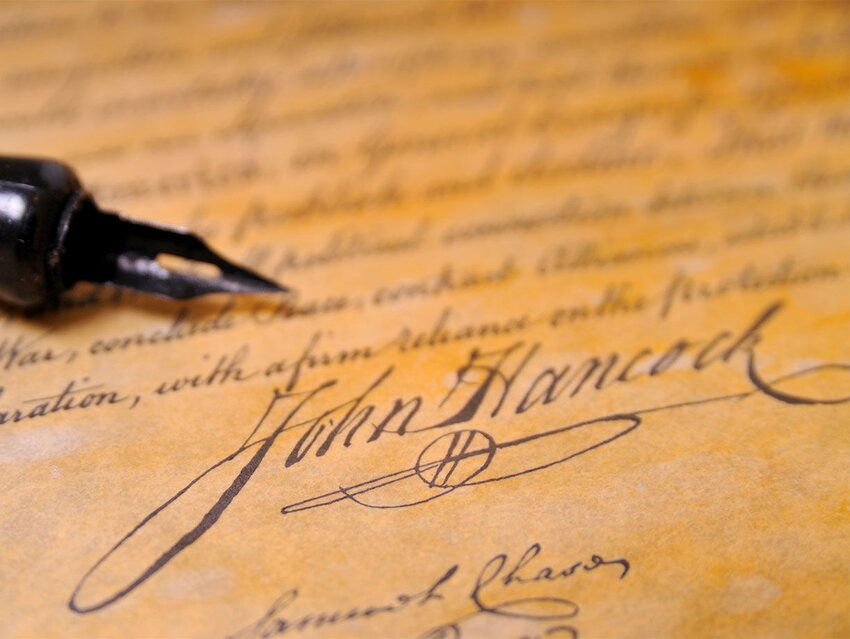We commonly pay tribute to notable figures by naming schools or bridges after them, but the English language itself is also scattered with eponyms — words named after specific people. Some words are derived from the names of the inventors who created the things in question, or from trailblazers who were the first to achieve specific feats. Others are names of notoriety that have been long forgotten. Here are a few eponyms to pull out for your next “Did you know…?” moment.
John Hancock
Perhaps one of the only first-and-last-name eponyms is the slangy “John Hancock.” Since he elaborately signed the Declaration of Independence in 1776, Hancock’s name has become shorthand for “signature,” especially in a ceremonial or official situation. However, it’s a myth that he signed his name so big as a taunt to King George III. As the president of the Second Continental Congress, he was the first to sign, so it’s possible he just didn’t understand how big his signature would appear next to those of the other signatories. Nowadays, a landlord might ask a renter, “Could you put your John Hancock on that?” to seal the deal on a new lease.
Boycott
Unsurprisingly, this eponym stems from an act of rebellion. In the late 19th century, English land agent Charles Boycott was known for harsh and even violent methods in collecting rents. Irish townspeople began refusing services to Boycott, leading to press coverage that coined the eponym as both a noun and a verb. While Charles Boycott’s situation was very specific, it occurred amid a conflicted political atmosphere in Ireland in the late 19th century, giving the eponym a greater chance to spread.
Nicotine
It’s common for a product or brand name to come from its founders — think Cadbury or Cadillac. But nicotine is a chemical, and it has no inventor. The name comes from the French ambassador Jean Nicot, who was introduced to tobacco while visiting Portugal in the 1550s. He brought the seeds and leaves back to Paris, convinced of the medicinal properties of the plant, and set off a centuries-long habit society still hasn’t managed to kick.
Achilles Heel
Some anatomical eponyms take inspiration from the Greek gods — the Achilles tendon, for example, is a band of fibrous tissue that connects the calf muscles to the heel bone. In Greek mythology, the semi-mortal character Achilles was considered “the bravest, handsomest, and greatest warrior of the army of Agamemnon in the Trojan War.” Legend has it that the sea nymph Thetis dipped the child Achilles in the waters of the River Styx, making him invulnerable, except for the part of his heel by which she held him, which ultimately led to his demise years later. The phrase “Achilles heel” has a metaphorical meaning of a weakness in spite of overall strength, which can lead to downfall.
Béchamel sauce
Béchamel sauce — the creamy, white sauce that provides the base for many indulgent dishes — consists of only milk, butter, and flour. The basic sauce is named after the French courtier Louis de Béchamel. He was heavily invested in Newfoundland fisheries, and he reportedly developed the sauce in 1654 to mask the flavor of dried cod he shipped across the Atlantic.
Bic
Quite the opposite of a Montblanc pen, Bic pens are designed to be virtually disposable. The name comes from French Italian businessman Marcel Bich, who grew from rags to riches when he acquired the patent rights to a ballpoint pen invented by the Hungarian Ladislas Biro, and formed Societe Bic in 1953. The pens exploded in popularity, and the company eventually branched out into lighters and disposable razors, and Bich became a billionaire.
Daguerreotype
This eponym refers to an early form of photography. Daguerreotypes were produced by an iodine-sensitized silvered plate and mercury vapor. Popular in the mid-19th century, the daguerreotype was the first commercially successful form of photography, though it was very expensive, so only the wealthy could partake. It’s named for its French inventor, Louis Jacques Mandé Daguerre.
Jacuzzi
While the use of heated water as a health aid is by no means a new concept, the Jacuzzi brothers revolutionized the practice when they emigrated from Italy to California in the early 1900s. The first hydraulic pumps they invented were used primarily for agriculture, but became more alike to the ones we use today when one of the Jacuzzis developed arthritis in 1956.
Mason Jar
Mason jars have experienced a modern renaissance, as they’re used in craft projects, home decor, hip cafes, and gastropubs. They get their name from American inventor Jason L. Mason, who patented the design in 1858. They took off in popularity for a few reasons — the bleached glass allowed canners to see what was inside (helpful for determining if the food inside was still safe for consumption), and the two-part top design allowed the jars to be reused. Sadly, Mason attained no wealth or glory for his now-ubiquitous invention — he sold the patent before the design took off.
Featured image credit: Marcopolo9442/ iStock

